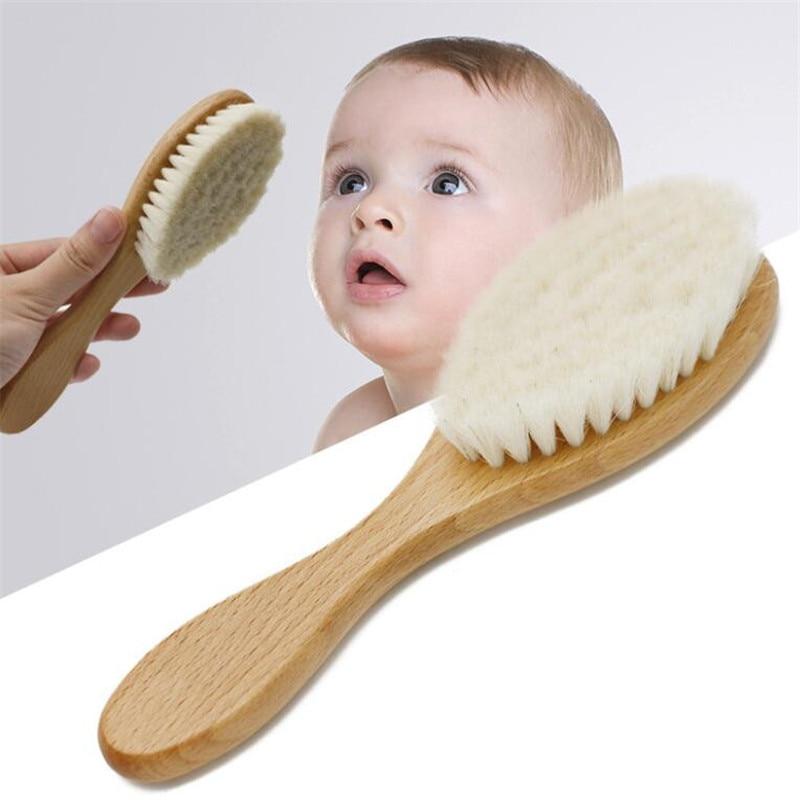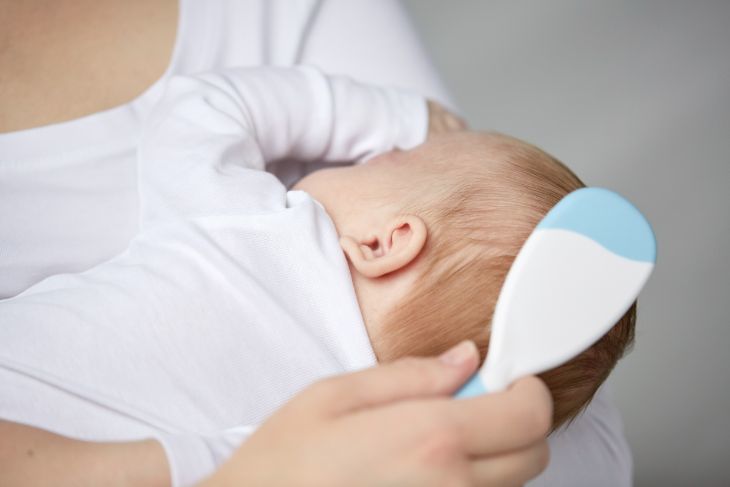Have you ever given much thought to how much daily brushing is required for your baby? It is important that you brush their hair regularly, but you should also be very careful about the way in which you do it. Here we will discuss some of the concerns and techniques that should be taken into account before beginning.
What should you consider?
The first thing to think about when planning on brushing a baby`s hair is whether or not they have sensitive skin. If so, this makes things all the more difficult. In such cases, it is extremely important to choose a soft-bristled brush with rounded back-end bristles. This helps prevent any sort of dragging or scratching from occurring during the grooming session. Be sure, however, that the brush is not so soft that it offers no resistance. If this happens, the brush will become ineffective and the bristles may detach themselves.
Also, be sure that you know how to use your chosen brush properly and efficiently before beginning with the brushing process. Many people tend to sweep and stroke from front to back, but this actually results in more of a tousling effect, which can make hair frizzier at times. You should always begin by gently stroking downwards from the top of your head towards the tips of your hair. This pushes down any tangles or knots without tugging too hard on them, which minimizes pain and discomfort for the baby.
Why do you need to do it every day?
When first born, your infant will most likely not require any brushing of their hair on a daily basis unless it is extremely long. However, as they grow older and begin crawling around on the floor more often, they are bound to pick up all sorts of dirt and debris. It is vital that you begin brushing their hair regularly so that you can remove these potentially harmful particles before they have the opportunity to somehow get inside their scalp or eyes.
The frequency with which you brush also has an effect on how long their hair stays looking healthy. If you brush once every day, this helps give the hair strands a little bit of extra shine. If you wait too much time between brushing sessions, however, it could leave them looking dry and dull. It is important to find a happy medium and stick to it if you want their hair to look its best.
How often should you brush your baby`s hair?
The frequency with which you need to brush your baby`s hair depends on what type of hair they have. If it is thick and coarse, then daily brushing will be necessary for them so that you can get rid of the tangles and knots before they become unmanageable. On the other hand, if your child has fine curly or wavy hair, this usually does not require as much maintenance as coarser straight-haired types. You should be able to get away with it a couple of times a week at most.

What should you do if your baby is bald?
Children who are completely bald or have very little hair tend to have more sensitive scalps. This means that brushing their hair is a much trickier task. In such cases, it is recommended that you use a soft bristle brush as mentioned above, but instead of dragging it through the hair shafts, you can simply dab and tap at their scalp with it. It does not require the pulling motion which can cause pain and discomfort for babies in this situation.
If your baby has very sensitive skin and they cannot tolerate even the lightest touch of a brush on their head; then there are alternatives available for you to use. You can try using an infant comb instead, which only requires enough pressure applied to allow the teeth of the comb to glide across their scalp, but no pressure or touching is actually required. You can also try using your fingers in place of a brush when brushing.
What about water?
It is also important that you keep brushes clean – there`s no point in brushing your baby`s hair when you are just transferring dirt around onto their head. Daily cleaning is recommended; however, depending on the frequency of use and type of brush, it may need to be done more often. Just avoid using any detangling products before the first grooming session. Products such as this can accumulate inside a brush and result in bristles becoming less effective over time.
Things that need to be avoided
Firstly, do not use wire brushes or anything with metal parts near your baby`s scalp, as they will pull at the roots and increase the pain caused during grooming sessions. Second – never clean a brush by wiping it along a table edge. This results in dirty bristles being dragged across a surface which is very unhygienic and dangerous.
How do you brush my baby`s hair?
Start by gently stroking downwards from the crown of their head, towards the tips of their hair. Make long strokes and then gently lift the top section of hair up into a ponytail and stroke it down to ensure that there are no tangles within the roots. Now gently pull out any tangles you can feel with your fingers, one by one.
Once this has been done, brush your baby`s hair again – this time making sure to start at the scalp (rather than backward) and pull through in short strokes until all knots have been brushed away. Then make one final stroke starting at the roots, pushing through towards the tip, which will (hopefully) leave you with a smooth, tangle-free finish.
What will you need?
A brush that has soft-bristled tips and is gentle on your baby`s delicate scalp; grooming gloves or wipes for cleaning purposes; shampoo for children (optional) ; detangling spray (optional).
How to brush curly hair?

Brush your baby`s hair in the direction it grows. Don't brush against the way the hair is growing because that will cause tangles. Here are some tips on how to brush curly hair:
- If your baby has curly hair, you can use a soft-bristled brush with widely spaced bristles.
- Brush your baby's hair when it is dry and detangle it with a wide-toothed comb before you wash and condition it.
- Use a moisturizing shampoo for children that will keep the hair soft and prevent tangles.
- Gently brush through your baby's hair while applying light pressure, starting from the ends of the curls and working up to the roots. Be sure to use slow strokes instead of rubbing.
- If your baby has non-elastic curly hair, gently scrub his scalp in a circular motion in the direction of his hair growth using a back-and-forth motion with a fine-tooth comb or with fingertips. This will loosen any crusty or scaly material without pulling on his roots.
How often should you brush my baby`s hair?
The best thing to do is not wait until their hair becomes knotty, but instead to start early and make it a habit. You will find that brushing their hair from a young age will help them to become accustomed to the process and be more patient during the sessions when they get older.
In fact, many parents find that having experienced regular grooming from infancy means that teenagers are much easier to manage when it comes time for them to start learning how to look after their own hair properly.
Why does my baby seem to hate being brushed?
If your child has never been used to having their hair brushed, you will notice that they might not be very pleased by the experience at first. In fact, it can sometimes feel as if your baby is actually trying to wriggle out of reach whenever you try to start grooming them.
However, this does not mean that he or she hates being brushed – in most instances, babies simply do not understand how a brush works and are scared by the unfamiliar sight and feel of it. Furthermore, some parents make the mistake of using a brush with stiff bristles on a young child – these can cause irritation and discomfort which only makes things worse for both parties involved.
When should you start brushing my baby's hair?
Babies can have their hair brushed from when they are a few weeks old, but you should wait until their umbilical cord has been removed and it has healed. It is also recommended that you do not brush a baby's scalp if they have nits or lice. You may be able to remove any bugs this way, but there is a high risk of transferring them to other family members.
How to choose a good brush for your baby?
There are many different options to choose from when it comes to young children's grooming tools. However, the best brush for a baby is one that has soft bristles and widely spaced bristles at the tip of the tuft.
Also, be sure to check the brush for a wide, non-slip grip – this will make it easier for you to hold on to and will stop your child from trying to grab it. A grooming glove or baby wipes would also come in handy as they can be used both before and after brushing. You may even find that a detangling spray makes things easier for you – just spritz some onto dry hair and use a wide-toothed comb to loosen up any tangles after applying it.
Conclusion
To summarize, here are some of the key points that we have discussed:
- Brush your baby`s hair down from the crown and towards the roots.
- When brushing avoid dragging out tangles by making long strokes. Instead, gently lift sections of hair away from their skin and brush - working through knots as you go along.
- Begin by stroking downwards from the top of the head. Then gently pull hair into a ponytail and stroke downwards against the scalp to remove any tangles within the roots (repeat this). Finally – make one final downward stroke, moving in short movements towards the tip until all knots have been brushed through.